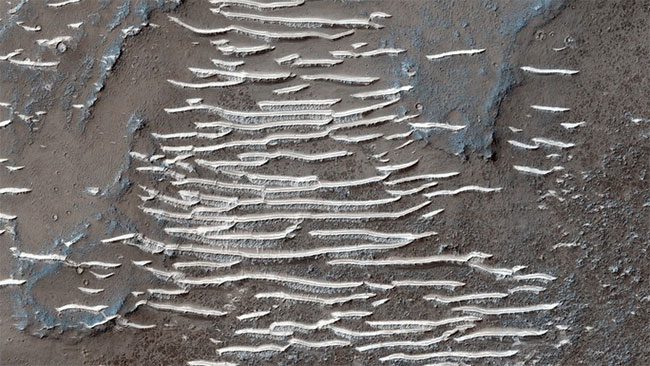The region with structures resembling ancient ice staircases captured by NASA’s Mars Reconnaissance Orbiter (MRO) could be an ideal location for the upcoming search for extraterrestrial life.
According to Space, the mysterious image taken by NASA is located at Solis Planum, to the south of a mixed geological region known as Noctis Labyrinthus, and is part of the southeastern area of Valles Marineris, a vast canyon system on Mars.
The strange formations appear to be ancient stone staircases, similar to those carved into mountains by ancient Earth civilizations, yet they are white and icy.

“Icy Staircase” on Mars – (Photo: MRO/NASA)
These mysterious staircases are a type of structure known as transverse aeolian ridges (TAR), which scientists from the University of Arizona suggest could provide a gateway into the complex history of a world once filled with water and possibly life on the Red Planet.
Initially, they were thought to be ripples formed from sand, shaped by a complex and random movement of the wind, making them appear more unusual than sand dunes found elsewhere on Mars.
However, the latest research, based on in-depth analysis of the images, has led to another intriguing clue. The authors suggest that these formations are actually “a network of ancient channels that have been broken.”
Interestingly, they propose that two elements could have created these ancient channels: lava or water.
If it is lava, that’s still good news, as lava indicates a “living” planet with active volcanic activity, suggesting ongoing geological processes that are crucial for maintaining a stable atmosphere and environment suitable for life.
If it is water, that would be a golden discovery, as water is the strongest link to life. If water flowed there, it’s highly likely that organisms once inhabited that area, even if they were only primitive microorganisms, enough to support the hypothesis that Earth life is not alone in the solar system.
For a long time, based on preliminary evidence, scientists have believed that Mars—like Earth and Venus, located in the Sun’s Goldilocks zone—once had water and life, before an unfortunate event stripped it of its atmosphere, water, and turned it into the arid landscape we see today, leading to extinction of life.
This new discovery provides an intriguing “flag marker” for one of the places that NASA’s future life-searching missions and many other space agencies around the world should explore.


















































